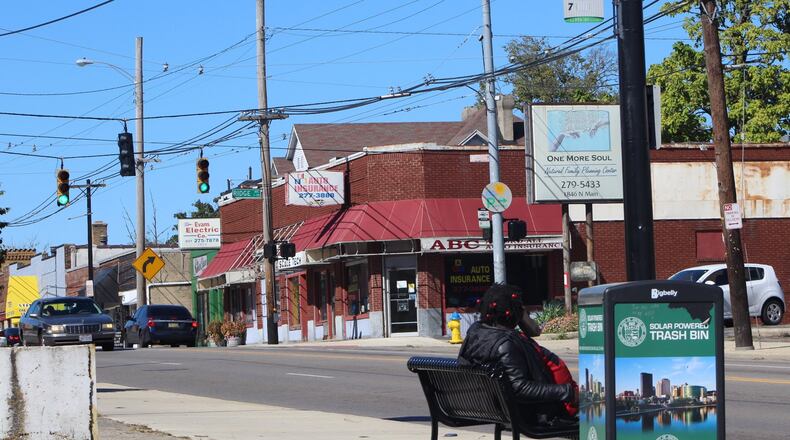A plan is only as good as the action that comes behind it, but some neighbors of Dayton’s North Main Street believe the area may finally be headed toward a turning point.
“Next year, we plan on opening another two or three businesses on that street,” said Dave Furst, who owns the Santa Clara Juicery with his wife, Elizabeth. “We have some private investors in place that will be working on it.”
The Fursts have opened two businesses in the corridor and Dave Furst said he sees opportunity for several more.
Problems persist
North Main Street used to be a “city-within-the city,” according to a draft of the city’s North Main corridor plan.
In the 1950s, the street had a thriving commercial center near Santa Clara Avenue. There were apartments, single-family homes, offices, banks, restaurants, a movie theater, shops, post offices and other commercial uses.
But by the 1990s, many of the corridor’s smaller mom-and-pop businesses had closed or moved to the suburbs.
Many residents moved out, and fewer moved in.
About 12,300 people lived in neighborhoods along the corridor between 2012 and 2016, the city’s plan states. That’s down from more than 18,000 in 2000 and almost 19,450 in 1990.
Neighborhoods along the corridor include Five Oaks, Hillcrest, North Riverdale and Santa Clara.
Neighborhood demographics changed. About three-fourths of residents were white in 1990. Now more than two-thirds of residents are black (68.4 percent).
Median home values in the corridor’s neighborhoods have tumbled, falling to $32,200 in 2017. That is down 9 percent from 2014 and 32 percent from 2011, the plan states.
Crime in the area has edged downward since 2010, but neighbors say open-air drug use, drug dealing, prostitution and violence remain common.
Main Street still has many businesses, including bars, child care centers, fast-food restaurants, markets and gas stations. But along certain stretches, more commercial properties are boarded-up and abandoned than are occupied.
The corridor also is not very pedestrian friendly.
Some motorists zoom up and down the drag, driving at unsafe speeds while navigating “dead man’s curve,” which is the name some locals have given to the bend in the road at Victor Avenue.
Over the years, unhappiness with conditions in the area prompted some local residents and business owners to speak out at city commission meetings.
They have frequently asked city leaders to increase the police presence in the area, change policing strategy and take other measures combat crime and unsafe conditions.
The Plan Ahead
The Dayton Plan Board recently approved the new, 57-page North Main Street corridor plan, which seeks to address crime concerns and contains dozens of recommendations for fighting blight, illegal dumping and other issues.
The plan recommends creating a neighborhood crime watch network and installing surveillance cameras along the business district.
It calls for cleaning up blighted, overgrown and crime-ridden alleyways and making environmental safety changes, like installing decorative lighting and closing alleys to create open community green spaces.
The plan suggests installing pedestrian flashing signs, crosswalks and islands and using traffic-calming devices to make it difficult for motorists to travel above the posted speed limits.
To stabilize the real estate market, the plan encourages using mural art to beautify blank walls and facades and forming a citizen inspector patrol group to identify properties that can be repaired and those that need to be demolished.
Other recommendations include: enhance gateways, beautify the corridor, create more pocket parks, improve recreational connections and other changes.
“I do personally support the plan, and I really appreciate that the city and some of the staff are paying attention to our part of the city because it really needs help,” said Lindy McDonough, who lives on Sandalwood Drive.
McDonough, the president of the Hillview neighborhood, said she believes a strong business association would be a big help because the business district is the most visible part of the corridor.
She also asked for a commitment from the city to undertake projects to improve the corridor.
Neighbors said the corridor has been the subject of other attempts at revitalization and what is important now is that this plan doesn’t sit on a shelf collecting dust.
“In order for this to work, we have to have a collaboration between the city and the residents,” said John Humphrey, a lifelong resident of the area who lives on Fairview Avenue.
The Fursts also own the Evans Electric Co., which exists next door to their juicery.
Dave Furst said Evans Electric has tripled in size since he bought the business last year. The juicery, which employs five people, sells smoothies, bottled juices, juice shots, coffee and teas.
The juicery and electric business are bright spots on a section of North Main that has a string of empty and abandoned store fronts.
Dave Furst said he plans to invest further in the neighborhood he’s come to love. He said he’s been moved by residents heart-breaking stories of crime, drug addiction and misfortune.
Furst said he hopes he can help bring to the corridor take-out delis with healthy food, a “take-and-bake” pizza place and a healthy pet food store.
Furst said the city can have a big impact with simple things like cleaning up parking lots and installing better lighting and more trash cans.
About the Author

